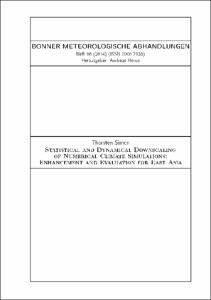Statistical and Dynamical Downscaling of Numerical Climate SimulationsEnhancement and Evaluation for East Asia

Statistical and Dynamical Downscaling of Numerical Climate Simulations
Enhancement and Evaluation for East Asia

| dc.contributor.advisor | Hense, Andreas | |
| dc.contributor.author | Simon, Thorsten | |
| dc.date.accessioned | 2020-04-20T03:51:44Z | |
| dc.date.available | 2020-04-20T03:51:44Z | |
| dc.date.issued | 28.11.2014 | |
| dc.identifier.uri | https://hdl.handle.net/20.500.11811/6203 | |
| dc.description.abstract | The overall aim of this thesis is to present methods, which improve evaluating dynamical downscaling approaches or enhance statistical downscaling schemes. These methods are illustrated along examples of both approaches for the East Asian region. The transfer of information from a large scale to a smaller scale is referred to as downscaling. Two different approaches are employed in climate science for downscaling purposes, i.e. textit{dynamical downscaling} and textit{statistical downscaling}. In order to give a better description of the downscaled data, this thesis presents methods, which help evaluating and interpreting the data and results of further studies in a better way, for both approaches. Dynamical Downscaling is based on a spatially limited atmospheric general circulation model, a so-called regional climate model (RCM). At the boundaries of the RCM lateral boundary conditions (LBC) are provided by a climate simulation performed with a global general circulation model (GCM). This thesis proposes methods for evaluating RCM simulations. First, a qualitative evaluation, that investigates whether single atmospheric dynamics are resolved by the RCM, is presented. Second, a newly developed evaluation method, that investigates by cross-spectral analysis on which temporal scales a RCM is able to generate variability independently from the GCM defining the LBC, is introduced. To this end, cross-spectra are estimated point-to-point between the RCM and a bi-linearly interpolated version of the GCM defining the LBC. Both methods are illustrated along RCM simulations performed for a domain covering East Asia. The RCM COSMO-CLM has been adapted for this purpose, and was driven by climate simulations performed with ECHAM5 and the re-analysis ERA-40 at its boundaries. The qualitative evaluation shows that both summer monsoon and winter monsoon dynamics are resolved by COSMO-CLM. The cross-spectral analysis suggests that the potential of COSMO-CLM to generate variability independently from the GCM depends on both dynamical features, i.e. monsoons and inter-tropical convergence zone, and on numerical parameters, i.e. horizontal resolution and domain extension. Statistical downscaling is based on statistical transfer functions between the output of large scale climate simulations and observations on the local scale. While an abundance of statistical methods for this kind of purpose are available, it is crucial from case to case to find physically meaningful predictors, which allow further interpretations of the results. Deriving and applying such predictors is demonstrated along a statistical downscaling study for precipitation properties in the Poyang catchment in Eastern China. The dichotomous variable, if 24~h accumulated rainfall exceeds a certain threshold, is taken from local rain gauges for summer. Empirical orthogonal functions (EOF) are calculated for relative vorticity at 850~hPa and vertical velocity at 500~hPa taken from ERA-40 re-analysis data. Both information are linked by logistic regression. The most dominant EOF-predictor can be associated with meso-$alpha$-scale disturbances, which are part of the summer monsoon dynamics in this region. Downscaled data is often requested for further studies in climate science, but also in other disciplines. Thus, developing evaluation methods for assessing the quality of RCM simulations, and deriving physically interpretable predictors for statistical downscaling schemes are crucial enhancements for the downscaling procedure. | |
| dc.language.iso | eng | |
| dc.relation.ispartofseries | Bonner Meteorologische Abhandlungen ; 66 | |
| dc.rights | In Copyright | |
| dc.rights.uri | http://rightsstatements.org/vocab/InC/1.0/ | |
| dc.subject | Regionale Klimamodellierung | |
| dc.subject | Statistische Datenanalyse | |
| dc.subject | Vorhersage Verifikation | |
| dc.subject | Starkniederschlagsereignisse | |
| dc.subject | Ostasiatischer Sommermonsun | |
| dc.subject | Regional Climate Modeling | |
| dc.subject | Statistical Data Analysis | |
| dc.subject | Forecast Verification | |
| dc.subject | Extreme precipitation events | |
| dc.subject | East Asian Summer Monsoon | |
| dc.subject.ddc | 550 Geowissenschaften | |
| dc.title | Statistical and Dynamical Downscaling of Numerical Climate Simulations | |
| dc.title.alternative | Enhancement and Evaluation for East Asia | |
| dc.type | Dissertation oder Habilitation | |
| dc.publisher.name | Universitäts- und Landesbibliothek Bonn | |
| dc.publisher.location | Bonn | |
| dc.rights.accessRights | openAccess | |
| dc.identifier.urn | https://nbn-resolving.org/urn:nbn:de:hbz:5n-38378 | |
| ulbbn.pubtype | Erstveröffentlichung | |
| ulbbnediss.affiliation.name | Rheinische Friedrich-Wilhelms-Universität Bonn | |
| ulbbnediss.affiliation.location | Bonn | |
| ulbbnediss.thesis.level | Dissertation | |
| ulbbnediss.dissID | 3837 | |
| ulbbnediss.date.accepted | 10.11.2014 | |
| ulbbnediss.institute | Mathematisch-Naturwissenschaftliche Fakultät : Fachgruppe Erdwissenschaften / Meteorologisches Institut | |
| ulbbnediss.fakultaet | Mathematisch-Naturwissenschaftliche Fakultät | |
| dc.contributor.coReferee | Simmer, Clemens |
Dateien zu dieser Ressource
Das Dokument erscheint in:
-
E-Dissertationen (4116)




